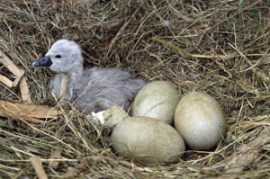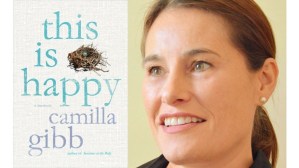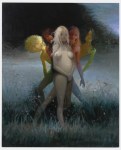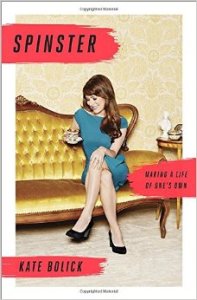The following piece was first published in 2001, but watching Mute Swans in Toronto’s High Park today reminded me of a time when I had a lot invested in these beautiful creatures. I became part of a group of “swan-watchers” who daily checked on the progress of the nesting, hatching and growth of the cygnets. For hours I would sit on the grass by a pair as they tended to what turned out to be unviable eggs. Still we sat until they were long past due, and I pinned all my hopes on those eggs hatching as a sign that my life in Vancouver would be successful. Here’s a story I wrote for the local paper about the dramatic events that unfolded in Lost Lagoon that spring.
![IMG_2175[1]](https://carlamarialucchetta.com/wp-content/uploads/2013/05/img_21751.jpg?w=314&h=235)
These are delicate creatures and we’ve done them a disservice by holding them captive for aesthetic purposes – to beautify our parks – and thereby making them vulnerable to harm while stopping them from living out their natural lives.
LOST LAGOON SWANS, 2001

On June 13th, after 37 days of incubation, four cygnets were born to a pair of Mute Swans nesting in Lost Lagoon. The hatching began at 9 am when the first ball of wet, grey down tumbled out of one of the eggs. At 2:30 pm a second cygnet burst out of its shell, this one ivory coloured, with unusually pink feet and a lighter grey beak that its sibling. Evidently exhausted from their efforts to break free of their embryonic shelters, the babies napped frequently while their parents waiting patiently for five more hours until the final two beaks started poking out of their eggs. The tiny grey “twins,” as they were dubbed, toppled out within a couple of minutes of each other at around 7:30 pm. Delight and relief were immeasurable among a group of Stanley Park “regulars” who had been keeping vigil at three swan nests since mid-April, as if their very presence would send positive energy for a healthy, new generation of Lost Lagoon swans. A week later, only one cygnet remained alive, the three others were killed, eaten or drowned. In the past few years, the hatching, and rearing of swans has been precarious at best, and rumours abound among this dynamic group of wildlife watchers as to why.

The Vancouver Parks board characterized this year’s cygnet hatching as a “miracle,” for more than one reason. At approximately 16.5 hectares in area, Lost Lagoon is thought to be much too small for more than one pair of nesting swans, since swans typically require an area at least the size of the whole of Stanley Park (1,000 acres) to accommodate the protectiveness they exhibit while they incubate, hatch and bring up their young. Two other female swans laid seven eggs each but all were lost, allegedly either from spoiling, predators like racoons and otters, or to humans. The four cygnets that did hatch were laid by a young mother who, at two years of age, had supposedly not yet reached reproductive maturity, since Mute Swans usually do not lay their first eggs until at least three years of age. Her partner is estimated to be in his twenties, and to never have successfully parented any young. Although swans habitually mate for life, this male’s partner died last year and it was his first mating season with a new, much younger female. Mike Mackintosh, of the Vancouver Parks Board, who has been involved with the swans in Stanley Park since the 1960s, is not concerned with their low birth rate. “The nine we have now is a much more realistic and manageable number.” In the past they were much larger in number in the park, and were kept company by a few Australian Black Swans that were subsequently stolen, and some native North American Trumpeters and Tundra Swans, that eventually moved on.
The Mute Swan is perhaps the most replicated of all the swans species in art, poetry and literature, and commercially in company logos, insignias, and advertising. This is the one species most known to people, due to the fact that it was introduced to North America from England over a hundred years ago, and lives in parks, lagoons and waterways across this continent, close to urban areas. Most Mute Swans are considered relatives to the “royal” English Swans, raised along the Thames River and therefore originally the property of the British royal family, except for a sub species known as Polish Mutes, who have pink feet, compared to the black of the English Mutes and, when mated with them produce a white or light coloured cygnet rather than the usual grey. They are admired for their natural, ornamental beauty (especially when they cup their wings above their backs) and, in their semi-domesticated homes in urban settings, they have learned to have little or no fear of humans, and are therefore susceptible to their attention.

The Mute Swans in Stanley Park are the descendants of the original number that were introduced from England in the park’s early history. Although the record keeping on the Stanley Park swans has been poor at best, Mike Mackintosh remembers that fifty years ago as many as seventy-five lived in the natural habitat of Beaver Lake and Lost Lagoon, which both provided plenty of what the Swans thrive on—a vegetarian diet consisting of pond weed, various grasses, and some invertebrates like insects, molluscs and tadpoles. Over the years, through natural attrition due to old age and death by predators, their numbers gradually dwindled. At certain points new swans were introduced in an effort to avoid inbreeding. The Mute Swans are distinguished from the native North American Trumpeter and Tundra Swans by their black knobs that protrude above their bright orange beaks (the knob is more pronounced in the male Mute, than the female). They are known for their territorial nature, especially during nesting periods, and in order to keep them from mixing with or moving the other species out of their migratory spots, the Mute Swans are required by law in Canada to be pinioned. This procedure, which is recommended to be done in the first 2-5 days in a cygnet’s life, but which is carried out three or four months into their life at Stanley Park, permanently prevents the swans from flight. The great debate about whether pinioning is humane or not remains unsettled, but by most accounts it is a relatively painless cut made in the wing of a young bird before it grows its flight feathers, so the swan is none the wiser about its ability to fly. The result is a bird that is perceived to be more domesticated, but which is still governed by the survival-of-the-fittest laws of nature, and any close observer of our Mutes can easily see that these two factors are in constant conflict these days in Lost Lagoon.
It is only since 1998 that the swans have begun reproducing again after a five-year dry spell, with only three cygnets surviving and growing to adulthood. Swans typically lay between three and seven eggs per season, so if they are in good reproductive health, they can hatch up to seven cygnets. In a protected and thriving environment, all seven would live to adulthood, mate and reproduce. In Lost Lagoon in 1998 three cygnets hatched, two of them died of a parasitic infection caused by algae in the lagoon, and one was killed by an off-leash dog. Out of the three hatched in 1999, two survived (one of them being the young mother of the four cygnets this year). And in 2000 one went missing and one lived. Many park regulars silently, and some openly, accuse the Parks Board of having an unspoken policy to control the number of swans in the Lagoon. As the Parks Board mandate is more about providing a natural, recreational playground for residents and tourists than it is about protecting the wildlife, many feel that it simply doesn’t care. Particularly unprotected are the swans, which are stuck here, in an inadequately small space, fighting for territory, their young vulnerable to too many close by predators, and a few known human repeat offender feeders. With the exception of Ziggy Jones, a park “wildlife technician” who, because they are not migratory, feeds the swans a supplemental amount of wheat grass, duck pellets, park staff cannot be everywhere at once keeping track of the wildlife in the park. An Eco-Rangers program is in effect in the summer months only, where twice a day volunteers go out into the park to remind visitors about the “no-feeding” by-law and to try to educate them on why feeding wildlife is harmful. Many of the prohibitive no-feeding signs are hidden by foliage, particularly in the lush spring and summer months. Mike Mackintosh admits that the Vancouver Parks Board needs to get more serious about enforcing the by-law, especially in light of recent coyote attacks. His lists of the problems feeding and overfeeding causes include overpopulation of wildlife, disturbance of natural balances, higher risk of wildlife disease, an increase of rodents and other pest species, habitat damage, and physical injuries to people,
This year, with only four swan eggs making it to hatching time, regulars commiserated that the Vancouver Parks Board was simply not being diligent enough to ensure a successful breeding season. A years-old rumour resurfaced about the Parks Board addling and spoiling the eggs, and then pointing media attention to wild predators or humans to cover up their below the radar agenda on control. Mike Mackintosh’s reply to that is, “Why would we want to shake the swan eggs, as if there is some kind of evil intent.” In fact the Parks Board does have a policy about rounding up Canada Geese, and limiting their large numbers. “In the case of the swans,” he says, ‘I just sort of shake my head and say, Get a Life!”
Among the group of regulars, there are distinctions as to which members have the best interests of the swans in mind, and those who have perhaps too much of an emotional investment in them and have forgotten that they are wildlife, and not mere pets, or worse, human. The former are lovers of waterfowl and wildlife alike and respectfully observe, take photos, and chat with other nature-lovers, as well as keep the Parks Board and Stanley Park Nature House (the two on-sight organizations) informed of any harm or mischief being perpetrated on park wildlife. The latter are the repeat feeders, who believe that there is not enough natural food in the Lagoon for the swans and have taken the care and feeding of them upon themselves, sometimes to a harmful conclusion.
The unofficial leader of the “swan-watchers” is a woman named Jean who, after many years of keeping an eye on park wildlife, has by far the best memory and documentation of the swans. She also knows who belongs on which side in terms of healthy and unhealthy interest in the swans, and pulls no punches when it comes to telling people not to feed them, get too close, or to please put their dog on a leash. Everyday throughout the spring during the long transit strike, she travelled from New Westminster, walking into the park from the closest Skytrain station and could be found somewhere along the Lost Lagoon path, between the three swan nests. She kept copious notes on when each swan laid which egg and likely knew more accurately than the Stanley Park Nature House staff and the Parks Board itself about when the hatching would begin. She explained to any and all that hatching was not guaranteed and that even if the cygnets hatched, they may not live to adulthood. She happily showed off her photos from last year and she spoke lovingly about how the proud parents fuss over their young, described the cygnet’s first swim, and the way they ride the lagoon on the protective backs of their mothers, their little beaks peaking out from her wings. Her enthusiasm, tinged with sadness for the lost cygnets over the years, easily ignited interest in others about the pending births. Over the course of the time of the nesting, the group grew in number. Some members were first-timers, some old-timers, and all gravitated toward Jean to learn the latest progress of the swans. By the end of May it looked like only one set of swans would produce the coveted cygnets, and “regulars” could be seen peering over the fenced-off nest closest to the causeway as the hopeful parents stubbornly tended to their eggs, although they were long past their hatching date. Soon, all focus and anticipation was directed to the four remaining eggs in the middle nest. And what had started out as a few people strolling along the Lost Lagoon’s 1 km pathway had turned into a group of people with a common interest meeting to chat about life and nature in the company of the swans.

It is not surprising then that when the first two cygnets went missing, it was one of the “regulars” who first noticed, and another who found one of the bodies and brought it in to Ziggy Jones, the waterfowl caretaker. It was less than a week after their birth, and just as they were becoming experts at climbing on and off the nest to swim and learn to feed, trying to mimic their parents’ neck-dive to the bottom of the lagoon to forage for food. The speculation was that the inexperienced mother was lured to the opposite side of the lagoon by “the swan lady” who claims to have raised them for more than thirteen years by feeding them abundant amounts of food, sometimes bird seed, often times cat food. The swan, clearly used to being fed by this woman, took her young too often into the territory of the other swans that were still in their defensive nesting mode, despite losing their eggs. As well, they were much easier prey for herons, crows and other predators on the open lagoon. After several witnessed battles between the male swans, it was concluded that the grandfather of the cygnets (the male of the unsuccessful “causeway” pair) finally found one of them swimming too far from the protective wing of its mother. Ms. Jones sent the found body off for a necropsy and to date, two months later, the results are not known. After that the parents became more cautious, but the food on the other side of the lagoon still held a fascination for the mother and off she went, continually putting her two remaining cygnets in danger. A few days later one more cygnet vanished and Ms. Jones took the final one into protective custody at an undisclosed place in Stanley Park, where she is raising it in a wading pool for the next few months. She plans to first place it in a farm yard in the park, and by fall she will put it back into the lagoon. She is aware that by then even the cygnet’s parents may not recognize it and that no matter when she re-introduces it could prove dangerous, but she maintains that in the fall, with the nesting season long over, the Lagoon is a quieter, more tranquil place, where the swans co-exist more peacefully. She has based this decision on her six years of experience looking after the Stanley Park waterfowl, her own rearing of birds and plenty of pertinent reading. As a “wildlife technician” for Stanley Park, she has no related educational credentials, and expresses frustration with the Parks Board’s budgetary constraints on wildlife protection. When asked if she consulted waterfowl experts on her decision to take the cygnet away from its parents she replies, “I don’t even have a computer.”
As many people as there are who want the cygnet protected, there are likely as many who think it should have been left to nature’s order. This is the gist of Zoe Renaud’s response to whether or not a cygnet should be taken from its parents at such a young age. As a certified wildlife rehabilitator, at the Wildlife Rescue Association in Burnaby, she receives many calls about injured or abandoned birds and animals and empathizes with Ms. Jones on her decision to remove the cygnet. “When you pinion the swans you basically turn them into a domesticated animal. In the wild a cygnet would never be taken from the protection of its parents. In Stanley Park the worst that can happen is that it will be forced away from the flock of swans and rely on the companionship of humans.” Ms. Renaud also understands that this falls into the other risk categories of over domestication of wildlife. “There is no right or wrong answer here,” she says, “They are already living unnaturally.”
Melanie Beeson, founder of the Swan Sanctuary in Surrey, England advises that our cygnet is quite special as it is in fact a Polish Mute which, she says, tend to be more delicate. “I would say a Polish cygnet tends to need his parents that little bit more. This could be why you’ve lost cygnets in previous years.” She recommends reintroducing the cygnet sooner than later to diminish the risk of rejection.
For the first time in many years, the swans basked in the limelight of media attention. The Vancouver Sun carried a daily account of the life of the cygnets, and both VTV and Global Television featured segments on them. Many regulars were reluctant to speak on camera or be quoted in print and were so protective of the swans and their story that one reporter, sensing a conspiratorial air, commented, “This is about the swans isn’t it?” What was really happening was wariness about the way ordinary people had been implicated in the media as part of the problem, and frustration with the misrepresentation of the swans as vicious, or neglectful parents. The oft quoted Ziggy Jones claims that she was misquoted in the stories. After allowing the Vancouver Sun a photo of the cygnet in its new home, she is refusing any other media access for the time being. That photo, and another one just published clearly shows the cygnet to be “ivory” the second born with white down and pink feet, who possesses the less common genes of the Polish Mute, and therefore is a rarity. “No,” says Ziggy, “it’s the second lightest one.” Several photographs taken by the regulars prove, however, that there was never a second lightest coloured cygnet in the clutch. The others were the typical grey colour, with dark beaks and black feet. All are mystified by this confusion and await the day they can actually see the young swan, whose gender also won’t be known until it is taken to the vet for pinioning in another month or so.


































